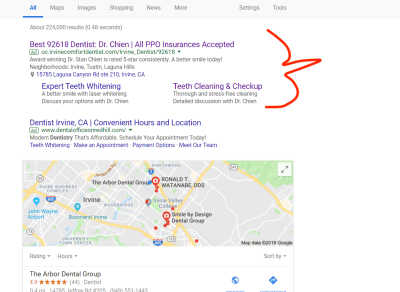Google Ads for Boat Repair and Maintenance Services is a powerful tool that helps you put your business in front of potential customers at the exact moment they’re searching for boat repair services. Instead of relying only on word-of-mouth or seasonal demand, you can use Google Ads to attract more leads year-round, target the right audience, and grow your business faster.
What is Google Ads?
Google Ads is an online advertising platform that allows businesses to display their ads on Google’s search results, websites, YouTube, and other partner platforms. It operates on a pay-per-click (PPC) model, meaning advertisers only pay when someone clicks on their ad.

How Does Google Ads Work?
- Advertisers bid on keywords : These are the words or phrases people type into Google when searching for a service or product.
- Google shows relevant ads: When someone searches using a keyword you bid on, your ad may appear at the top of the search results.
- You pay only for clicks: You’re only charged when someone clicks on your ad and visits your website or calls your business.
Types of Google Ads
Search Ads: Text-based ads that appear on Google search results.
Display Ads:Image or banner ads shown on websites across the internet.
Video Ads: Ads that appear on YouTube videos.
Shopping Ads: Ads showcasing products for e-commerce businesses.
Local Services Ads: Ads for local businesses, ideal for service-based industries like boat repair.
Why Use Google Ads?
- Reach customers actively searching for your service
- Control your budget: Set a daily or monthly spending limit
- Get measurable results: Track clicks, calls, and conversions
- Fast visibility: Appear at the top of search results instantly
For a boat repair business, Google Ads helps attract boat owners in need of immediate repairs, ensuring your services are visible to the right audience at the right time.
Google Ads vs. Traditional Advertising Methods
When you compare Google Ads to other types of advertising, a few benefits stand out:
Cost-Effectiveness
With Google Ads, you only pay when someone clicks on your ad, ensuring that your advertising budget is spent on engaged users. Traditional methods often require significant upfront investment with no guaranteed return.
Targeted Reach
Google Ads has precise targeting options that let ads reach people in certain locations, demographics, and even based on their interests. Traditional advertising does not get as specific, so it usually reaches a bigger, less-targeted group of people.
Mobile Reach
Google Ads helps you reach customers on their phones wherever they are, whether they’re searching online or watching YouTube. Traditional ads, on the other hand, do not reach as many people because people might miss a TV commercial, a billboard, or a newspaper ad.
What to Do Before Starting Google Ads for Boat Repair and Maintenance Services
Before you launch a Google Ads campaign for your boat repair business, preparation is key. A well-planned campaign can bring in more calls, bookings, and customers, while a poorly planned one can waste money without results. Here are the important steps to take before you start running ads.
1. Define Your Goals
First, ask yourself: What do you want to achieve with Google Ads? Your goal will help you create the right type of campaign.
- More calls: If you want customers to call you directly, you need a Call Ads campaign.
- More form submissions: If you want leads through your website, you’ll need a landing page with a simple contact form.
- More foot traffic: If you want boat owners to visit your shop, focus on Local Services Ads with your address and reviews.
Clearly defining your goal will help you measure success and adjust your strategy if needed.
2. Know Your Target Audience
Google Ads allows you to target specific types of customers, so you need to identify who your ideal customers are. Ask yourself:
- What type of boats do my customers own (yachts, fishing boats, jet skis, etc.)?
- Where are most of my customers located? (Near a marina, lake, or coastal area?)
- What problems do they face? (Emergency repairs, regular maintenance, engine trouble?)
Understanding your audience helps you write better ads and choose the right keywords to attract boat owners looking for your services.
3. Conduct Keyword Research
To show up in Google searches, your ads need the right keywords. These are the words and phrases potential customers type when looking for boat repair services. Some examples include:
- “Boat repair near me”
- “Yacht engine maintenance [city]”
- “Marine fiberglass repair”
- “Outboard motor repair service”
Use Google’s Keyword Planner to find keywords with high search volume and low competition. Picking the right keywords ensures your ads reach people actively looking for boat repairs.
4. Analyze Your Competitors
It’s always a good idea to check what other boat repair businesses are doing on Google Ads. Search for services like yours and see which ads appear at the top. Look at:
- The type of language they use in their ads
- The keywords they are targeting
- Their offers (e.g., free estimates, same-day service)
If competitors are running Google Ads successfully, you can learn from their strategies and find ways to make your ads even better.
5. Set a Budget
Deciding how much you want to spend is crucial before starting your campaign. Google Ads allows you to set a daily or monthly budget, so you’re always in control of your spending. Some key points to consider:
- Start small: Test your ads with a modest budget ($10–$20 per day) and increase it if you see good results.
- Monitor performance: Adjust your budget based on which keywords or ads bring in the most leads.
- Consider competition: If many businesses in your area are running ads, you may need to increase your bid to stay competitive.
Before jumping into Google Ads, take the time to plan. Setting clear goals, understanding your audience, choosing the right keywords, analyzing competitors, and budgeting wisely will set your boat repair business up for success.
How to Set Up Google Ads for Your Boat Repair and Maintenance Services
Running Google Ads can be a powerful way to attract more customers to your boat repair and maintenance business. Whether you’re fixing engines, cleaning hulls, or offering general maintenance, this guide will walk you through the process of setting up a Google Ads campaign step by step. Let’s get started!
Step 1: Set Up Your Google Ads Account
- Go to Google Ads: Visit ads.google.com and sign in with your Google account. If you don’t have one, create one.
- Create a New Campaign: Once you’re in your dashboard, click on the “Campaigns” tab on the left-hand side, then click the “+” button to create a new campaign.

Step 2: Choose Your Campaign Goal
Select Your Objective: Google will ask you to choose a goal for your campaign. For boat repair and maintenance services, the best option is “Leads” because you want people to contact you for quotes or bookings.

Campaign Type: Choose “Search” as your campaign type. This means your ads will show up when people search for keywords related to your business (e.g., “boat repair near me” or “boat maintenance services”).

Type in your website and contact number

For Campaign Settings: Make sure to unclick both Google Search Partners Network and Google Dispaly Network

Step 3: Set Your Bidding
Bidding Strategy: Start with “Clicks” as your bidding strategy. This ensures your ads get shown to people who are actively searching for your services. And then click on Set a maximum cost per click, which later on you’ll have to set on manual CPC.

Step 4: Target the Right Audience
- Location Targeting: Choose the areas where you want your ads to show. For example, if you’re a boat repair service in Miami, target Miami and nearby coastal areas. Click on Enter another location

Type in the location that you would want to target.

Click on Location Options and click Presence: People in or regularly in your included locations.

Language: Select the language your customers speak (e.g., English).

Ad Rotation: Choose Do not optimize. Rotate ads indefinitely


For Start and End Dates: Simply enter your start and end date for your campaign.
Ad Schedule: Set your ads to run during business hours when someone is available to answer calls or emails.

Keyword and Asset Generation: Google Ads automatically generates information from the website you entered.

Step 5: Create Your Ad Groups
One Service Per Ad Group: Create separate ad groups for each service you offer. For example:
-
- One ad group for “boat engine repairs”
- Another for “boat hull cleaning”
- Another for “general boat maintenance”
Keywords: Add relevant keywords to each ad group. Use phrase match (e.g., “boat repair near me”) to target people searching for your services.

Keyword Match Types
Understanding keyword match types helps you control who sees your boat repair and maintenance ads and how you spend your money. Match types tell Google how closely your keywords should match what people search for.
1. Broad Match
Widest reach. Your ad shows for searches broadly related to your keyword, including synonyms or similar ideas. Good for discovery, but watch closely.
Example for boat repair:
- Your ad might show for “yacht maintenance” or “marine engine fix.”
2. Phrase Match
Your ad shows if the search includes your exact keyword phrase (or a close version) with other words before or after it.
Example for “outboard engine repair”:
- Your ad might show for “cost of outboard engine repair” or “emergency outboard engine repair near me.”
3. Exact Match
Your ad shows mainly for searches that are your exact keyword or very close versions with the same meaning. This gives you the most control but the smallest audience.
Example for “[boat hull repair]”:
- Your ad would mostly show for “boat hull repair” or “repair boat hull.”
Step 6: Write Your Ads
Google automatically generates details for your ads but you can edit and add if you want.

Headlines: Write clear and compelling headlines.

Descriptions: Use the description to highlight what makes your business unique.

Sitelinks are clickable links that appear below your main ad in Google Search. They help users go directly to specific pages on your website, like Contact Us, Pricing, Services, or About Us.


Calls and Leads are ways to track how many potential customers contact your business

Step 7: Launch Your Campaign
Review Your Settings: Double-check your budget, targeting, and ad copy.
In Google Ads, when you set a budget for a campaign, Google often provides three suggested daily budget options:
- Recommended Budget: This is the default option that Google suggests based on your campaign goals, industry benchmarks, and expected performance: It aims to balance reach and cost-effectiveness.
- Higher Budget: This option increases your daily spend, allowing your ads to reach more users and potentially generate more clicks or conversions. It’s useful if you want to scale your campaign quickly.
- Lower Budget: This option reduces your daily spend, limiting ad impressions and clicks. It’s a more conservative approach for businesses wanting to test results before committing more budget.


Publish Your Campaign: Once everything looks good, click “Publish” to launch your campaign.

Step 8: Monitor and Optimize
- Check Performance: Regularly review your campaign’s performance in the Google Ads dashboard.
- Adjust Bids: If certain keywords are performing well, increase your bids for those keywords.
- Add Negative Keywords: Exclude irrelevant keywords (e.g., “boat rentals” or “fishing boats”) to avoid wasting money on clicks that won’t convert.
Pro Tips for Success
1. Use a Landing Page
Instead of sending traffic to your website, create a simple landing page with a clear call to action (e.g., “Call Now for a Free Estimate” or “Schedule Your Boat Maintenance Today”).
A landing page is a special webpage designed to get visitors to take a specific action, like signing up for a newsletter, downloading a free guide, or buying a product. Unlike regular web pages, a landing page has one clear goal and usually includes:
- A catchy headline to grab attention
- A short explanation of what’s being offered
- A form or button to take action
- A few images or testimonials for trust
Think of it like a digital sales pitch—it’s focused, direct, and designed to turn visitors into leads or customers.
Strong, Attention-Grabbing Headline
Clearly states what you offer.
Example: “Expert Boat Repair & Maintenance – Get Back on the Water Fast!”
Eye-Catching Hero Image or Video
A high-quality image of a boat being serviced or a happy customer on the water.
A short video showcasing your team in action builds trust.
Clear & Concise Service Highlights
- Engine repair & maintenance
- Hull cleaning & restoration
- Electrical system diagnostics
- Seasonal tune-ups & inspections
Use bullet points to make it scannable and easy to read.
Strong Call-to-Action (CTA) Button
- “Get a Free Quote Today”
- “Schedule Your Repair Now”
Should be bold, visible, and repeated multiple times on the page.
Customer Testimonials & Reviews
Showcase real customer reviews or before-and-after photos.
Example: “These guys got my boat running like new in no time! Highly recommend!”
Trust Signals
- Certifications, years of experience, or affiliations (e.g., “Certified Marine Technicians”)
- Warranty or guarantee badges
- Secure contact forms with privacy assurance
Simple Contact Form
Keep it short: Name, Email, Phone, Boat Type, and Service Needed.
Option for a click-to-call button for instant contact.
Mobile-Friendly & Fast-Loading
Ensure it looks great on phones and loads quickly to avoid losing visitors.

Example Layout:
- Headline + Subheadline
- Image/Video of Service
- List of Services
- CTA Button (Above the Fold)
- Customer Testimonials
- Trust Badges & Certifications
- Contact Form & Click-to-Call Button
A well-designed landing page should be clear, simple, and action-oriented—guiding visitors to book a service without distractions.
2. Test Different Ads
Experiment with different headlines and descriptions to see what works best.
3. Highlight Special Offers
If you offer discounts or seasonal promotions, include them in your ads to attract more customers.
4. Be Patient
It may take a few weeks to see results, so don’t give up too soon.
Running Google Ads for your boat repair and maintenance business can help you reach more customers and grow your revenue. By following these steps, you’ll be able to set up a campaign that targets the right audience and generates high-quality leads.
If you need help setting up your campaign or want to skip the learning curve, consider working with YoYoFuMedia. Contact us today for a free consultation!






